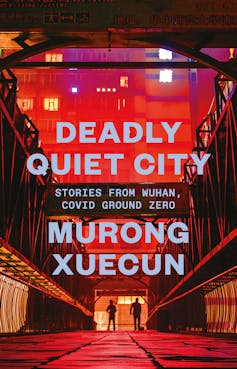inside the first days of COVID-19 in Wuhan, China
- Written by Anita Chan, Visiting Fellow, Department of Political & Social Change, Centre on China in the World, Australian National University

We have lived through two tumultuous years as the COVID-19 pandemic has swept through Australia. Our Prime Minister Scott Morrison took the lead, for domestic political purposes, in calling for an investigation into the origins of the virus in the Chinese city of Wuhan.
In January 2021, China finally agreed to let an international team of experts led by the World Health Organization into Wuhan to investigate. The findings of the team were inconclusive, because the Chinese authorities were not very cooperative and refused to approve a follow-up investigation.
Review: Deadly Quiet City: Stories from Wuhan, Covid Ground Zero – Murong Xuecun (Hardie Grant Books)
Infiltrating Wuhan
People who are curious to know why China is so resistant to outside investigation should read this book.
Another of the eight, a writer and member of the middle class, whose online essays tended to be critical of the government, managed to fly out of Wuhan to Guangzhou at four in the morning on the night the lockdown was announced. On hearing of Li’s death, he immediately started an online campaign, “Never Forget Li Wenliang”, to crowdfund a statue of the doctor. Within a couple of days, the state security bureau put him under house arrest.
Heartless bureaucrats and humanitarians
Some of the eight or their relatives contracted COVID. They recounted their encounters with heartless bureaucrats in graphic detail. Some of them had lined up for hours trying to see a doctor, or desperately made dozens of phone calls to friends and relatives who might have contacts with powers that be, to be able to find a hospital bed. Most had seen the chaos in hospitals: crying, begging, patients collapsing or dying while waiting.
A hospital cleaner had propped up her sick husband on a bicycle to search for a hospital that would take him. Those who successfully got into hospital were slapped with medical bills totalling a year or two of their annual wage. They all confronted dismissive, callous bureaucrats trying hard to shift responsibility. If they dared to complain on social media – describing their sorry state, begging for help, and trying to raise money – they invited the presence of the police.
The stories also record humanitarian responses. The motorcyclist taxi driver had waived charges for sick people poorer than him. Pleas on social media for help to pay medical bills brought in needed money.
Another of the eight, Zhang Zhan, a citizen journalist who travelled to Wuhan when she heard news of the pandemic, was able to raise enough money to allow her to stay in Wuhan to post her daily reports on social media. In May she went missing. It was later revealed that she is in jail, sentenced to four years. She has been adopted by Amnesty International as a prisoner of conscience, and the latest news is that she is on a hunger strike.
Read more: Fang Fang's Wuhan diaries are a personal account of shared memory
Amplifying authoritarianism
There are many things we can learn about China from these eight stories. COVID has amplified the problems of an authoritarian system: endemic bureaucratic inefficiency, contemptuous treatment of “the masses”, shedding of responsibility, yet readiness to trade favours and succumb to corruption.
COVID has also exposed China’s broken medical system. This is not news to anyone who pays attention to China, but it’s educational to see how the malfunctions play out in such detail. Politics overrides science. Li and his colleagues were interrogated and punished for telling the truth, forced to make official “confessions”. Then, when Li’s warnings proved correct and went viral on social media, he was exonerated posthumously by the authorities, who declared him a national hero in order to placate the Wuhan residents’ anger.
As becomes clear in the book, doctors and nurses in small hospitals earn paltry monthly salaries – less than even poor migrant factory workers. They also need to toe the Party line. As an example, hospitals, all under Party management, were instructed to falsify their statistics in order to shrink the infection and death rates, so as to satisfy the national authorities’ policy of keeping those rates low.
Since deaths outside hospitals were deliberately not recorded, isolation wards were emptied of dying patients by sending them home, infecting their own families. A doctor lamented there was nothing he could do to prevent this. When the virus was partially under control, even though people were still lining up to get into hospitals, the Wuhan authorities celebrated the Party’s conquest of the virus with great fanfare.
A woman who would not be coaxed into accepting monetary compensation for the death of her daughter made a scene on the streets, marching with her daughter’s portrait and crying for justice. She received a phone call from the police in no time, telling her not to “publish sensitive remarks online” because this “would have a negative influence on the country … you must be vigilant against hostile anti-China forces. Don’t let them use you.” She finally acquiesced, after being put under surveillance for several months.
These are sad stories documenting Kafkaesque experiences of ordinary Chinese people. Sadder still is that the others – except for Zhang Zhan, who refused to stop calling out the lies – either lament their bad fate, or halfheartedly (or wholeheartedly) accept the Party’s propaganda. Domestic social stability and national security trump all other concerns.
Authors: Anita Chan, Visiting Fellow, Department of Political & Social Change, Centre on China in the World, Australian National University





